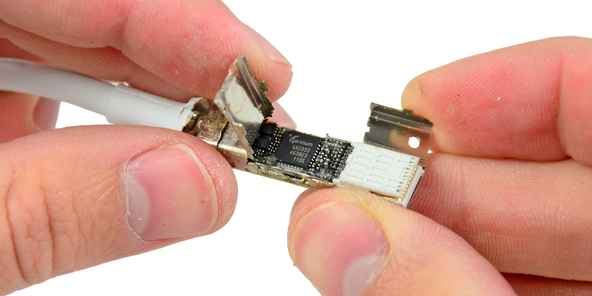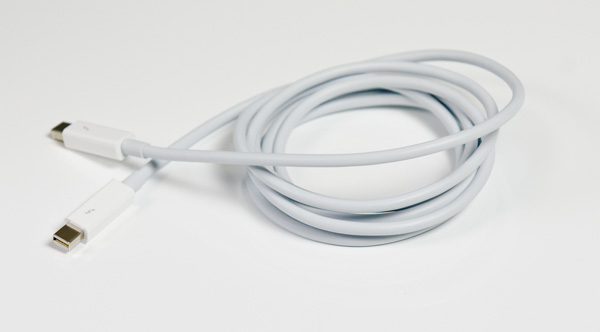Promise Pegasus R6 & Mac Thunderbolt Review
by Anand Lal Shimpi on July 8, 2011 2:01 AM ESTThe Thunderbolt Cable
Despite the $999 - $1999 price tag of the Promise Pegasus, it does not ship with a Thunderbolt cable. Apple currently offers a 2 meter long Thunderbolt cable for $49. As iFixit discovered this is an active cable with a Genum GN2033 transceiver in each connector:

Gennum GN2033 Transceiver in Apple's Thunderbolt cable - Image Courtesy iFixit
Thanks to all of the added components in the cable each connector is approximately 50.8mm long, much longer than the end of a standard DisplayPort cable.
The Genum transceiver and auxiliary components do generate heat under load. Using an IR thermometer I measured a connector surface temperature of 27.6C at the end plugged into my test MacBook Pro. The end plugged into the Pegasus R6 was warmer (presumably because of its close proximity to the drive cage) at 32.9C. Neither is too hot to handle but both are warmer than you typically expect from a cable plugged into the side (or back) of your computer.











88 Comments
View All Comments
takumsawsherman - Saturday, July 9, 2011 - link
You mean like booting from a CD or USB flash drive and copying files to a very small, hideable storage container?Perfectly possible, and in fact I find myself doing this frequently (though copying the data in the other direction typically) when disinfecting PCs. I do this multiple times per week, removing data stealing trojans and rootkits.
Compare with Thunderbolt, where you will "sneak in with only a laptop and a cable and reboot and press T, and ZOMG yor datas are hax0red! Ha HA ha stupid Apple!!!111oneonewonwon"
Leaves obvious traces? Exactly what traces did the Boot CD leave?
Penti - Wednesday, July 13, 2011 - link
As you can password protect (which can be bypassed with physical access any way) the firmware it doesn't matter if it is Firewire/Thunderbolt-target or USB-stick/HDD that access and or copies the files or simply a CD that changes your password so you can just log in an access everything without any effort at all. If you don't have limits on the firmware/bios any way you can just set up whatever, and access anything without any effort, less so then using slow target disk mode, even through network boot is possible which might be on in a corporate/university environment any way.Just disable the good damn features you don't like, it don't make your computer safe but I'm sure it will quit you whining for nothing.
You will just access everything by running the system rescue tools on the install CD for OS X any how. Windows computers are essentially unprotected any way. So I really don't see how it's any worse then plugging in a USB stick to access everything or change the password (SAM) to blank/whateveryoulike. Screaming about a ten year old feature is just dumb. Just set up a firmware password and it stops people from simply booting a CD, USB-drive, HDD-drive, using target disk mode and network boot any way. It's simply not more vulnerable then PCs any way. It's quite easy to restore the firmware-password thus bypassing it on say an iMac any way, I could easily do it on older macs without taking the entire computer apart. And on a PC of course resetting CMOS password is often troubleless and manufacturers often has master passwords you get by calling the support any way. Later macs has got better protection from resetting the firmware password though. So just set the damn password.
Penti - Friday, July 8, 2011 - link
They are not driving the screen with a separate control-board. That's why target display is so awkward. You can expect third party stuff (and older macs) will work when Atlona has designed and released an Thunderbolt-compatible adapter/switch/converter/scaler though. It a integrated solution not a screen and a computer separate. The screen is when used normally connected directly to the ATi/AMD 6000M GPU. That's why you can't adjust the screen in Bootcamp/Windows without their software tool too.HW_mee - Friday, July 8, 2011 - link
That makes sense, not much you can do to separate the two things if the screen is "merged" with the computer. I expected the computer part and screen part was seperate and the display input could be used in the same way as with most multiple input screens.If that was the case, a simple power circuit could control the screen and computer separately.
youngjimmy - Friday, July 8, 2011 - link
'Failing to do so will give you this all-*to*-familiar error' (bottom, The Pegasus: Software)Kimbie - Friday, July 8, 2011 - link
You made mention about connecting up a monitor to the last port on the chain, by plugging in a thunderbolt cable into the imac and used it as a second screen.Does this still work if you use a mini-display port to DVI adaptor and into a bog standard DVI monitor?
Kimbie
Focher - Saturday, July 9, 2011 - link
Just to clarify, the last connection in the chain to a mini DisplayPort monitor does not require a Thunderbolt cable. You would just use a mini DP cable.André - Friday, July 8, 2011 - link
Does it support JBOD?Would be really great for us using ZFS+ arrays, although I would have preferred at least 8 bays.
Exodite - Friday, July 8, 2011 - link
The performance is impressive, though nothing like what you'd get transfering a large number of smaller files obviously.That said, for 2000 USD why wouldn't I simply build a high-end desktop /with/ 12TB of storage?
It'd still be cheaper and I could put the remainder towards a gilded sticker for the case saying 'cheap-ass NAS'.
André - Friday, July 8, 2011 - link
It would appear that is the solution for you, building your own NAS.This enclosure is, however, not a NAS.
It enable users that need high disk performance to get easy access to precisely that in a mobile package you can take on the road with you and edit in the field.
Think large Final Cut Pro (or any other NLE), Logic Studio and Photoshop projects.